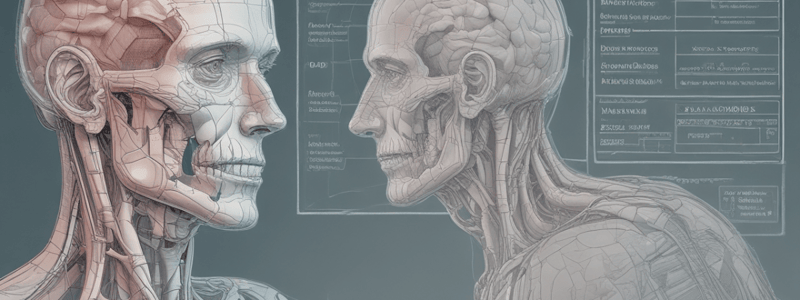Podcast
Questions and Answers
When evaluating the stomach using ultrasound, which direction should the transducer be swept to visualize the pyloroduodenal junction?
When evaluating the stomach using ultrasound, which direction should the transducer be swept to visualize the pyloroduodenal junction?
- Caudally
- Right side (correct)
- Cranially
- Left side
What is the formula used to calculate bladder volume using ultrasound measurements?
What is the formula used to calculate bladder volume using ultrasound measurements?
- Length x Width x Height x 0.523 (correct)
- Length x Width x Height x 1.5
- Length x Width x Height x 2.0
- Length x Width x Height x 0.5
What is the layer of the stomach that appears hyperechoic in cats due to fat deposition?
What is the layer of the stomach that appears hyperechoic in cats due to fat deposition?
- Mucosa
- Muscularis
- Submucosa (correct)
- Serosa
What position should the transducer be in to evaluate the stomach in short axis?
What position should the transducer be in to evaluate the stomach in short axis?
Which area of the urinary bladder should be evaluated carefully during ultrasound?
Which area of the urinary bladder should be evaluated carefully during ultrasound?
What axis should the urinary bladder be evaluated in during ultrasound?
What axis should the urinary bladder be evaluated in during ultrasound?
Flashcards are hidden until you start studying
Study Notes
Ultrasound of the Stomach
- Position the transducer at the xiphoid and slide it caudally to obtain a short-axis view of the stomach.
- Capture both long- and short-axis images of the stomach for comprehensive evaluation.
- When moving towards the right side, locate the pyloroduodenal junction, characterized by a thickened muscularis layer between the pylorus and proximal duodenum.
- In imaging dogs and cats, notice that the cat’s submucosa appears hyperechoic due to fat deposition.
Ultrasound of the Urinary Bladder
- Position the transducer centrally and caudally in the abdomen to assess the urinary bladder.
- Obtain both long- and short-axis images for complete bladder evaluation.
- Pay special attention to the trigone area, especially as it transitions into the urethra or prostate gland in male dogs.
- The bladder volume can be calculated using the formula: Length x Width x Height x 0.523.
Studying That Suits You
Use AI to generate personalized quizzes and flashcards to suit your learning preferences.




